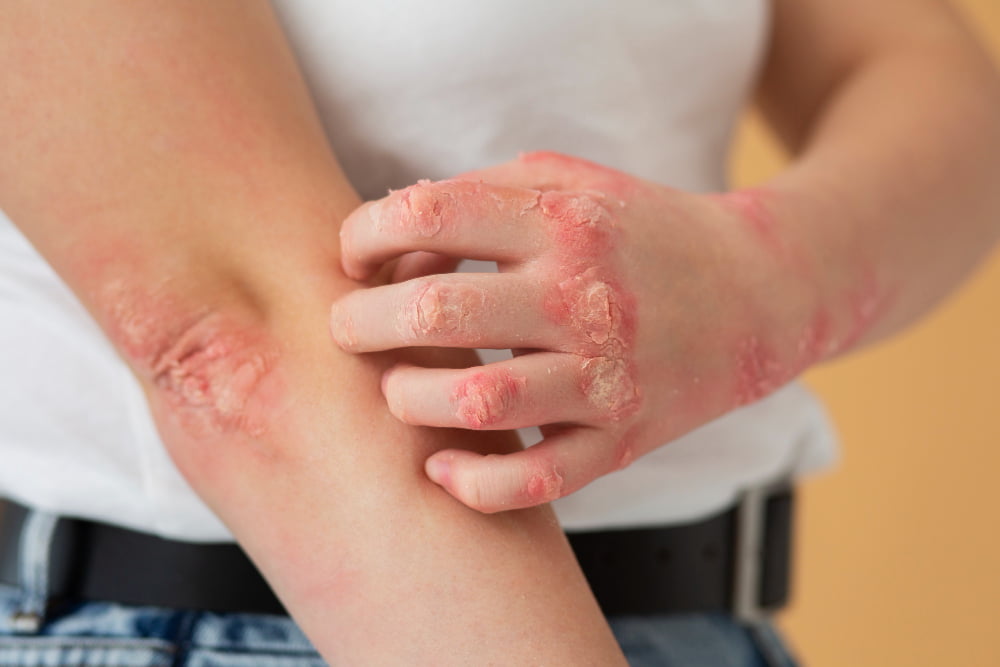
Weekdays : 8.30 am – 5.30 pm
Sat: 8.30 am – 12.30 pm

Sat: 8.30 am – 12.30 pm
Identifying Red, Itchy Skin Flare-ups

Disclaimer: This article has been created for informational purposes only and is not intended to provide medical advice or be a substitute for professional medical advice, diagnosis or treatment. Always seek the advice of your doctor or other qualified health providers with any questions you may have regarding a medical condition.
Eczema, also known as dermatitis, is a common skin condition that affects millions of people worldwide. Red, itchy and sometimes painful patches of skin are common signs of eczema.
It is crucial for those who suffer from this condition to understand what its causes, triggers and treatment options are.
It is a term used to describe a group of skin conditions that cause inflammation, redness, itching, and dryness. Atopic dermatitis, which people often use interchangeably with eczema, is the most common type. Other types include contact dermatitis and nummular eczema, each with its own unique triggers and characteristics.
Often seen in children, atopic dermatitis is the most prevalent type of eczema. It is a chronic condition defined by red, itchy skin patches, which can ooze and crust over time.
Contact dermatitis occurs when the skin comes into contact with irritants or allergens, leading to an itchy rash. It can be divided into two subtypes: irritant contact dermatitis and allergic contact dermatitis.
This type of dermatitis features round, coin-shaped patches of irritated skin. They can be highly itchy and are commonly located on the arms and legs.
Dyshidrotic eczema affects the palms, soles of the feet, and the sides of the fingers and toes. It causes small blisters that are intensely itchy.
The symptoms of eczema can vary, but common ones include:




The exact causes of eczema are not entirely understood, but several factors contribute to its development:



Eczema appears as red, inflamed patches of skin that are often dry and scaly. In some cases, blisters may form, leading to oozing and crusting. These symptoms can occur anywhere on the body but are most common on the hands, face, elbows, and knees.
Identifying and avoiding triggers is essential for managing eczema. Common triggers include:






Eczema is primarily associated with itching, but in some cases, the affected skin can become painful, especially when it cracks and oozes. Scratching the itchy areas can also lead to pain and further irritation. It’s essential to refrain from scratching to prevent worsening discomfort.
While there is no cure for eczema, there are effective treatments to manage and alleviate symptoms. These may include:





Eczema is a common skin condition that can cause red, itchy, and sometimes painful skin patches. Recognising the different types, symptoms, causes, and triggers is crucial for those affected. With proper management, including moisturisation, avoiding triggers, and medical treatment, individuals with eczema can lead healthier, more comfortable lives, free from the discomfort of their skin condition.
If you suspect you have eczema, it’s essential to consult a doctor or dermatologist for a proper diagnosis and personalised treatment plan. Early intervention can help manage the condition effectively and improve your skin’s health.




Dr Tan & Dr Ker are experienced dermatologists that have been treating patients suffering from atopic dermatitis (Eczema) for years

There isn’t a one-size-fits-all treatment to Eczema. Understanding the condition through a detailed assessment and customising a treatment for every patient is key to keeping Eczema in control.

The treatment for eczema in adults and children can differ, so it is important to find the most effective approach for each individual. Our specialists are experienced in treating eczema in both adults and children.